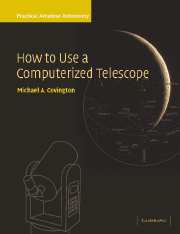Preface
Published online by Cambridge University Press: 10 February 2010
Summary
Computerized telescopes are revolutionizing amateur astronomy. Even the least expensive entry-level telescopes are now available with computer-controlled motors to find and track objects in the sky. No longer do you have to search for NGC 1999 or Neptune by carefully comparing the view with a star map – you just tell the telescope what to point at, and it does it.
Do computer controls take all the fun out of astronomy? No more than paved highways take the fun out of the Arizona desert. Professional astronomers have used setting circles to find objects since the time of Tycho Brahe and have always tried to make them as accurate as possible. Amateurs have long had setting circles, but they weren't very accurate. Now, with the advent of computers, professional-level accuracy is within the reach of the amateur, and the computer actually controls the telescope rather than just telling you where it's pointed.
After 30 years of finding celestial objects the old way, I bought my first computerized telescope in 2000 and immediately found myself doing a new kind of amateur astronomy. Suddenly I was spending my time looking at objects instead of for them. No longer preoccupied with “star-hopping”, I could spare the time and attention to study the celestial objects themselves.
In fact I realized for the first time that, for all those years, my observing program had been skewed by the fact that some objects are easier to find than others.
- Type
- Chapter
- Information
- How to Use a Computerized TelescopePractical Amateur Astronomy Volume 1, pp. xv - xviPublisher: Cambridge University PressPrint publication year: 2002

